
NGC 4911 is a disturbed, warped spiral galaxy with a bright prominent central starburst ring and located deep within the Coma Cluster of galaxies, which lies some 300 million light years away in the northern constellation Coma Berenices. NGC 4911 is believed to be interacting with its warped, barred lenticular companion, producing the enhanced star formation and shell-like appearance seen in optical images. The galaxy contains rich lanes of dust and gas near its centre. The existence of clouds of hydrogen within the galaxy indicates ongoing star formation. It is rare for a spiral galaxy to be situated at the heart of a cluster.
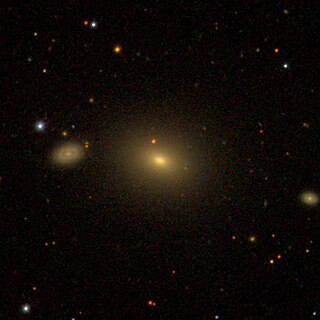
NGC 76 is a lenticular galaxy estimated to be about 320 million light-years away in the constellation of Andromeda. It was discovered by Guillaume Bigourdan from France in 1884 and its magnitude is 13.1.
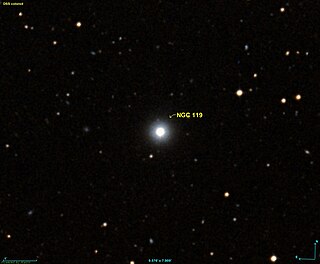
NGC 119 is an unbarred lenticular galaxy with an apparent magnitude of 13.0 located in the constellation Phoenix. It was discovered on October 28, 1834 by the astronomer John Herschel.

NGC 4500 is a barred spiral galaxy in the constellation Ursa Major. The galaxy was discovered on April 17, 1789 by William Herschel. It is a blue compact galaxy.

NGC 3294 is a spiral galaxy in the constellation Leo Minor. It was discovered by William Herschel on Mar 17, 1787. It is a member of the Leo II Groups, a series of galaxies and galaxy clusters strung out from the right edge of the Virgo Supercluster. The galaxy is located at a distance of 98 million light years and is receding with a heliocentric radial velocity of 1,586 km/s. The morphological class of NGC 3294 is SA(rs)bc, which means this is a spiral galaxy with no central bar (SA), an incomplete inner ring structure (rs), and moderately wound spiral arms (bc).

NGC 540 is a barred lenticular galaxy in the constellation Cetus. It is estimated to be 451 million light years from the Milky Way and has a diameter of approximately 120,000 light years. The object was discovered on October 15, 1885 by the American astronomer Francis Preserved Leavenworth.

NGC 995 is a lenticular galaxy located in the constellation Andromeda about 178 million light years from the Milky Way. It was discovered by the French astronomer Édouard Stephan in 1871.

NGC 830 is a barred lenticular galaxy in the constellation Cetus. It is estimated to be about 170 million light-years from the Milky Way and has a diameter of approximately 70,000 light years.

NGC 900 is a lenticular galaxy located in the constellation Aries about 430 million light-years from the Milky Way. It was discovered by the German astronomer Albert Marth in 1864.
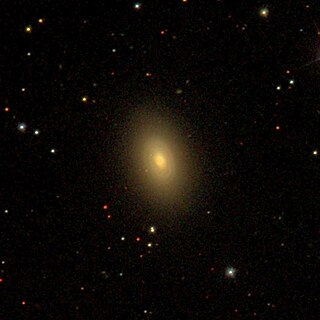
NGC 940 is a lenticular galaxy in the constellation Triangulum. It is estimated to be 222 million light-years from the Milky Way and has a diameter of approximately 80,000 ly. NGC 940 was discovered by Heinrich d'Arrest.

NGC 980 is a lenticular galaxy located in the constellation Andromeda about 256 million light years from the Milky Way. It was discovered by the German - British astronomer William Herschel in 1786.

NGC 530, also known as IC 106, is a lenticular galaxy in the constellation Cetus. It is approximately 226 million light years from the Milky Way and has a diameter of around 100,000 light years. The object was discovered on November 20, 1886 by the American astronomer Lewis A. Swift, who listed it as NGC 530, and rediscovered on November 16, 1887 by Guillaume Bigourdan, who listed it as IC 106.

NGC 814 is a lenticular galaxy in the constellation Cetus. It is estimated to be about 70 million light-years from the Milky Way and has a diameter of approximately 30,000 ly. NGC 814 was discovered on January 6, 1886 by the American astronomer Ormond Stone.

NGC 912 is a compact lenticular galaxy located in the constellation Andromeda about 197 million light years from the Milky Way. It was discovered by French astronomer Édouard Stephan in 1878.

NGC 534 is a lenticular galaxy located in the constellation of Sculptor about 260 million light years from the Milky Way. It was discovered by the British astronomer John Herschel in 1835.

NGC 823, also known as IC 1782, is an unbarred lenticular galaxy in the constellation Fornax. It is estimated to be 194 million light-years from the Milky Way and has a diameter of approximately 100,000 light years. NGC 823 was discovered on October 14, 1830, by astronomer John Herschel.

NGC 2803, also known as PCG 26181, is an elliptical or lenticular galaxy in the zodiac constellation Cancer. It was discovered March 21, 1784, by William Herschel. It is interacting with NGC 2802.
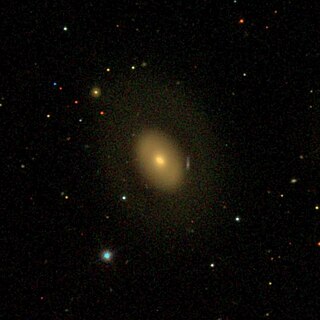
NGC 608 is a lenticular galaxy in the constellation Triangulum. It is estimated to be about 230 million light-years from the Milky Way. It has a diameter of approximately 130,000 light-years. NGC 608 was discovered on November 22, 1827, by astronomer John Herschel.
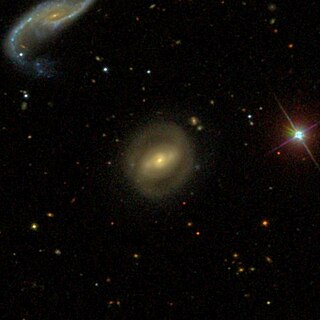
NGC 4614 is a barred lenticular galaxy in the New General Catalog. It is located in the constellation of Coma Berenices. It was discovered in 1864 by the German astronomer Heinrich d'Arrest with a 11.9 inch diameter lens type telescope.

NGC 4179 is a lenticular galaxy located in the constellation Virgo. It was discovered by William Herschel on January 14, 1784. It is a member of the NGC 4179 Group of galaxies, which is a member of the Virgo II Groups, a series of galaxies and galaxy clusters strung out from the southern edge of the Virgo Supercluster.




















